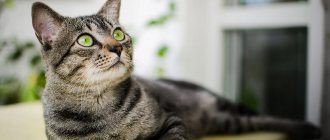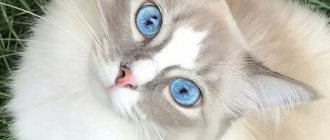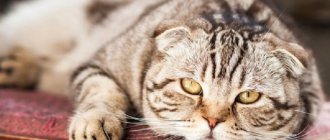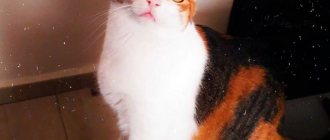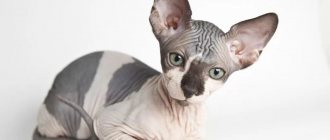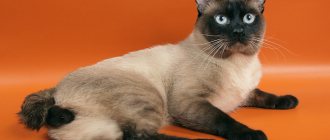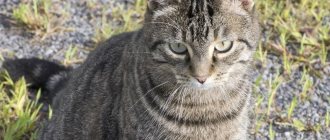Breed characteristics
Representatives of the breed are cheerful, cheerful and calm. By nature, they are closer to classic cats who like to nap in their free time from playing. Pets are small in size, their height ranges from 14-18 cm, and their weight reaches 3 kg. Animals can live in city apartments or private houses; they are not adapted for the street - representatives of the breed are completely hairless. Sometimes you can notice a light, colorless fluff on your stomach - this is normal.
Dwelf
A subspecies of the elf is the Dwelf cat breed. These amazing animals got their name as a derivative of two words: Dwarf cat (dwarf cat) and Elf (fairy-tale creature in the folklore of some peoples).
Dwelfs differ from their closest relatives in having short legs. This feature is the result of crossing the Canadian Sphynx, American Curls and Munchkins. It was the latter who awarded the Dwelfs the short-legged gene.
This breed is young, the first representatives appeared only in 2009. Hairless short-legged cats are not yet recognized by international felinological associations and are considered an experimental breed. Although, judging by their incredible popularity around the world, recognition is just around the corner.
How they appeared
The breed appeared relatively recently - the idea to experiment came from American felinologists in 2007. To obtain the desired qualities, experts crossed three breeds: Canadian Sphynxes, Munchkins and Curls. Now, looking at the result obtained during the experiments, you can see what traits the breed has inherited.
From the Canadian Sphynxes, Dwelfs got a completely naked body without hair or undercoat. From Curls they have funny ears, and from Munchkins they have rather short legs. Pets are miniature, which is assigned to the breed. It is not yet recognized, but many breeders from other countries are interested in kittens, which is gradually helping to increase the popularity of the breed. And it’s not far from official recognition and participation in prestigious competitions. Today, exhibitions are held among enthusiasts, and felinologists have certain breed standards.
History of the breed
The Dwelf breed was developed during long-term selection work undertaken by the American breeder Kristen Lead. A woman who had a hard time surviving the death of her pet, a Canadian Sphynx, from a genetic disease, decided to create a hairless breed, devoid of hereditary pathologies.
At first, by crossing Canadian Sphynxes and American Curls, they managed to get hairless offspring with curled ears. The kittens were called elves. Later, short-legged Munchkin cats were introduced into breeding work. The result was kittens with bare skin, “elf” ears and short legs. Thus the Dwelf breed was born.
The first Dwelf kitten was born in 2006. The breed was recognized by the TICA organization, but in experimental status. Other felinological organizations are in no hurry to recognize the breed and are awaiting detailed results of its study.
What do cats look like?
Dwelfs have a recognizable appearance. These are hairless cats with characteristic curved ears. They have short legs and an elongated body. Sometimes “fuzz” appears on the stomach; this is not a deviation from the standards. These cats are decorative, miniature - their body reaches no more than 20 cm in length. At the same time, the animal’s body is quite dense and muscular, it is excellently developed and has good muscle tone.
The color of the animal can be any - there are no restrictions. Among the Dwelfs there are red, spotted, black, white, and lilac cats. Color affects the color of the eyes - the eyes of an animal can be yellowish, green, or gray. There are no specific standards or restrictions in this either.
If you touch the animal, it will feel very pleasant to the touch. This is not the feeling that occurs when touching rodents. Dwelfs have a velvety skin that you want to pet. In addition to the belly, there is also fluff on the tail and nose. Don't think that this is a deviation. This breed was developed by felinologists.
Description of the breed
Despite their short legs and diminutive build, Dwelf cats are strong and strong. Body movements are graceful, plastic, and dexterous. The weight of an adult male does not exceed 3 kg, the female weighs up to 2 kg. Body length – up to 25 cm.
A description of the Dwelf breed according to the standard is given in the table.
| head | wedge-shaped, high cheekbones, vertically elongated, flattened, sloping forehead, wide bridge of the nose, dark lobe, slightly concave bridge of the nose, convex whisker pads |
| eyes | large, almond-shaped, bulging, green, olive, blue iris, heterochromia acceptable |
| ears | large, widely spaced, wide base, tips curved back |
| torso | graceful, toned, with developed, dry muscles, a strong, mobile skeleton, a long, thin neck, a voluminous, prominent chest, a rounded belly, noticeable ribs, the pelvic part is more massive than the shoulder |
| limbs | short, strong, sinewy, the front ones are noticeably shorter than the rear ones |
| tail | whip-shaped, thin, medium length |
| skin covering | soft, hot, covered with many small folds, pleasant to the touch, reminiscent of velvet |
Dwelf cats with the following defects are excluded from breeding:
- long limbs;
- straight ears;
- massive build;
- round eyelid cut;
- thick tail;
- inadequate character.
Colors
There are no restrictions on colors, as can be seen in the photo. Dwelf cats are characterized by any solid or spotted colors, including rare and original ones: tortoiseshell, chocolate, lilac, color point.
As the breed develops, having short hair is not considered a defect. After the firm establishment of standards, the experimental status of the Dwelf breed will be removed, but for now the following varieties of coat length are acceptable:
- velvet – bare skin, pleasant to the touch;
- velor - the body of newborn kittens is covered with short, dense hair, in most individuals it gradually disappears as they grow older;
- flock - the body is covered with soft, silky, tender fur up to 2 mm long, whiskers and eyebrows are absent;
- brush - the body is bare or flocked, and the limbs, muzzle, and tail are covered with medium-length coarse hair;
- soft brush - the body is naked, and the muzzle, limbs, tail, and anal area are covered with soft hair;
- Straight-haired is a rare species due to the absence of the hairless skin gene.
Difference from an elf
Dwelfs are direct relatives of elf cats. The external features of the former were influenced by the genes of 3 breeds, the appearance of the latter by 2. The elf is more similar to its ancestor - the Canadian Sphynx, has a similar graceful and strong physique, significant weight, reaching 6-7 kg. The Sphinx differs from the Elf only in its straight ears.
An adult Dwelf is similar in size and build to a Sphynx kitten. Ears curled like an elf's - a gift from a curl. The physique is similar to the “elven” one, but the weight is much less, and the limbs are disproportionately short - the result of the addition of munchkin genes.
Dwelfs are less wrinkled than their normal-sized counterparts. The largest number of wrinkles are located on the face and forelimbs.
Cat character
Dwelfs look unusual, but in character they are classic cats. They love to play, bask in the sun, and nap in a secluded corner. Pets of this breed are not at all aggressive and love their owners. You should not leave them alone for a long time - the animals will be seriously bored. This even leads to various disorders in cats (depression, lack of appetite). There are some things cats cannot do due to their physiology. Their short legs prevent them from jumping all over the apartment.
Character
Dwelf cats are affectionate, friendly, sociable, need human company, and become depressed from loneliness. They try to follow their owner everywhere, greet him from work, and watch his household chores. You can’t buy a kitten if you can’t be there all the time.
Usually a Dwelf chooses a single owner and treats the rest of the household kindly. The pet loves to sit on laps, willingly participates in children's activities, and does not show aggression towards a small child. He treats other pets calmly, communicates friendly with non-aggressive dogs, and does not attack hamsters and parrots.
Dwelf kittens are inquisitive and playful. Adult cats become sedate, balanced, calm, preferring rest on a bed to pampering.
The breed is highly intelligent, but can be capricious in carrying out the master's orders. It is necessary to raise a kitten from an early age, but without screaming or hitting. Dwelfs are touchy and vindictive, they forever remember rough treatment, and lose respect for their owner. Therefore, education should be based on love and patience.
How to keep a pet
All cats require regular vaccinations and examination by a veterinarian. Dwelf especially needs this - the animal requires care. It is imperative to follow a diet so that your pet does not have problems with the gastrointestinal tract. The peculiarity of the breed is that the cat is completely hairless. It must be kept warm and not exposed to cold. During the winter months, it is recommended to monitor the room temperature.
It is better to put mosquito nets on the windows in the apartment so that the animal does not fall out of the window. A cat of this breed will not survive outdoors, especially during the cold months. It can also break if dropped - the pet’s paws are too small. It is worth purchasing a special bed for the animal, which is best placed not on the floor, but on the sofa. It will be much warmer this way.
How to get a kitten
Buying a kitten is problematic; there are only a few reliable nurseries. Kittens that have reached 3 months of age, are vaccinated, and are independent are offered for sale. The seller is obliged to provide the buyer with a pedigree and a veterinary passport with vaccination records.
Do not buy a kitten without documents. The risk of stumbling upon a scammer selling an ordinary sphinx or a mongrel shaved animal is great.
A purebred Dwelf kitten externally meets breed standards. Healthy kittens are playful, inquisitive, non-aggressive, and not shy. Tears, nasal passages, ears, anus are clean. There are no scratches, wounds, or signs of dermatological diseases on the skin.
Price and nurseries
There are no breeders selling Dwelf cats in Russia and the CIS. You should look for purebred kittens in American nurseries.
The cost of kittens is high. The minimum price for a kitten in the pet category (companion) is 120 thousand rubles . You will have to pay several thousand dollars .
Animal care
Dwelfs do not have hair, which eliminates a whole range of problems. They don't leave fur everywhere and don't require brushing. They do not have parasites that can hide in their fur. This does not mean that you can completely abandon hygiene. You need to wash your pet, but not more than once a month. The easiest way to care is to wipe the skin with a special damp cloth. Sometimes a damp towel is enough to completely clean the skin of dirt.
Are special tools required? You can use shampoos designed for hairless cats. Baby shampoos are also great for washing such pets - they are soft and do not have a negative effect on the skin.
Maintenance and care
Elves are special pets that require the same special treatment. First of all, this concerns the lack of wool. Hairless cats must be kept warm; they do not tolerate drafts and cold.
In a cool room, they climb onto their owner's lap in the hope of warming up, or hide under the blanket on the owner's bed. There are special clothes for hairless cats, which they quickly get used to and do not resist putting them on.
Any hairless cat's skin needs regular skin care. It consists of daily wiping with wet baby wipes, as well as bathing from time to time. Most elves love bathing procedures and get great pleasure from them.
Ear care is also important. Due to the lack of fur inside the ear flap to protect against dust and dirt, hairless cats produce large amounts of wax. It must be removed regularly using a cotton swab and special sprays.
How to feed your pet
Feeding rules must be strict. Some owners do not take into account the fact that a cat of this breed is prone to excess weight. Considering this a fiction, owners sometimes refuse their pets nothing. Then they have to solve the problem of obesity in animals. For feeding, it is worth choosing a special food whose composition is optimal for a purebred animal. It is recommended to consult a veterinarian in this matter. If your pet exhibits undesirable reactions to food, it is worth replacing the food with something else.
Health
Dwelfs do not suffer from any serious illnesses and can potentially live up to 20 years. However, like most hybrids, they can inherit some diseases. It is worth paying attention to the cat's joints - due to the short legs, they bear a serious load. This could potentially lead to premature wear.
It is also worth monitoring your pet’s habitat. It is not recommended to allow sudden temperature changes in the apartment. Direct sunlight in some cases leads to burns - the animal’s skin is not protected from them.
By using the pet app on the Petstory.ru website, you can ensure complete safety for your pet. Through the application, the user will instantly receive advice from a veterinarian on any questions. Here you can make an appointment with a specialist at the nearest veterinary clinic. The application also provides a lot of useful information for the owner of a cat or dog.
Download the specialized application for pet owners Petstory on the IOS and Android platforms using the link – https://petstory.ru/prilozhenie-konsultacija-veterinar/.

